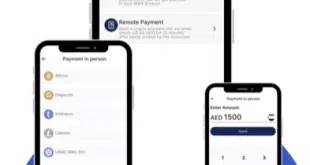By Peter Lucas
With three more years to comply with EMV, and with the cost of chip card acceptance weighing on their balance sheets, some petroleum marketers are talking about going mobile-only.
ExxonMobil, Phillips 66, Gulf Oil, Chevron. The list of oil companies rolling out or testing mobile-payment applications at the pump is growing by leaps and bounds. And why not? Mobile offers secure transactions, consumer convenience, and an abundance of loyalty and marketing options that can reach consumers in personalized ways.
Plus, it’s a cheaper alternative to installing EMV chip card readers.
For years, the high cost of installing EMV readers at the pump has been a common compliant from oil companies. It can cost $20,000 to $30,000 to retrofit all of a gas station’s pumps with EMV card readers, depending on the number of dispensers and provided the pumps are compatible with the available retrofit kits, according to Chicago-based W. Capra Consulting. That cost can rocket to between $50,000 and $80,000 if the pumps have to be completely replaced, a term known in oil-industry parlance as breaking concrete.
Installing mobile payments, however, can cost as little as several thousand dollars, payment experts say. For stations with 16 or more pumps, that represents a huge savings.
Equally enticing is that transactions made with mobile wallets are as secure as those made with chip cards. When a transaction is made using a mobile wallet, the wallet generates a token, an encrypted, digital key that stands in for the real card data during transmission between the terminal and processor.
In addition, the smart phones on which mobile wallets reside have their own set of security features. Using PINs or fingerprint recognition, they allow only the owner to use the device. Plus, with geolocation technology they can validate the device.
The primary reason for adopting chip card technology is that it eliminates fraud at the point of sale, since the chip authenticates the card to the POS terminal and vice versa. To be sure, this is a big plus in the fight against fraud, because it means terminals that have been tampered with by criminals to skim card data will be detected, and rejected, by the chip card.
Because of their long history of self service at the pump, gas stations historically have been a prime target for criminals. A fraudster can easily pull up to a pump, make a purchase, and insert a skimmer into a card reader, all without the knowledge of the staff inside the convenience store. It’s just as easy to retrieve the skimmer and all the data it captures.
Leapfrogging EMV
Now that the card networks’ deadline for the EMV liability shift for petroleum retailers has been pushed back to 2020 from 2017, oil companies are expected to take a hard look at whether mobile can be an alternative to EMV payments at the pump.
The liability shift moves responsibility for counterfeit card fraud from issuers to acquirers—and ultimately merchants—if the merchants are unprepared for EMV.
“The latest extension on the EMV liability shift gives oil companies time to move into mobile payments and experiment with it,” says Don Frieden, president and chief executive of Houston-based P97 Networks Inc., a provider of mobile-payment solutions for the oil industry. “We are already seeing some oil companies install express lanes that use mobile payment.”
Could the lower cost of mobile technology, and the security and convenience it offers, prompt some oil companies to do away with accepting cards completely at some pumps to lessen the financial hit of installing EMV? Frieden thinks so.
“It would be a little like the days when customers had a choice between full service and self service,” Frieden says. “If mobile can be positioned as a faster, more convenient form of payment, oil companies may be able to leapfrog EMV with mobile in those instances.”
Several oil companies are using P97’s solution. These include Gulf, Phillips 66, whose brands also include Conoco and 76, and To Go Stores Inc., a chain of 33 convenience stores in Puerto Rico.
Helping fuel the adoption of mobile payments at the pump is a mobile-payments specification developed by members of Conexxus, the convenience-store and fuel-retailing industry’s standards body. The standard enables interoperability between mobile-payment and loyalty applications. This allows oil companies to link myriad payment and loyalty schemes into a single, standardized data-exchange platform, paving the way for application developers to create a better user experience.
Oil companies can, for example, push incentives and rewards to consumers through the mobile app or create promotions that drive traffic at local stations, says Gray Taylor, executive director for Alexandria, Va.-based Connexus, formerly known as the Petroleum Convenience Alliance for Technology Standards.
Half Measures
Still, whether oil companies will be willing to install mobile-only pumps depends on consumer demand for the technology. For many mobile users, how big a role an app plays in their daily lives depends on the convenience it provides. In the case of mobile pay at the pump, a consumer can log in to an oil company’s app to locate the nearest station, be directed to a pump not in use at the designated station, and, after arriving at the station, select a payment card from her mobile wallet, all while sitting in the comfort of her car.
No more having to insert a credit or debit card into a card reader in foul weather or fumbling through her purse or key chain to swipe a loyalty card. The only time a consumer has to exit her car is after receiving a message on her app to begin fueling, at which point the consumer inserts the fuel nozzle into her gas tank, then returns it to the pump when finished.
“There is a segment of consumers asking for mobile pay at the pump,” says Margaret McDonnell, senior director of credit card operations for Gulf Oil. “But how large that segment will become remains to be seen. I suspect there will be some stations that test splitting mobile and EMV.”
In February, Gulf rolled out its Gulf Pay mobile payment application. The app, which uses P97’s platform, allows Gulf customers to locate the nearest Gulf station, pay for fuel at the pump, and purchase products inside the convenience store. Users can also see current pricing, receive directions to the nearest station, and view special offers, such as a free soda with a fill-up. Gulf is piloting the program at select stations in New England and New York during the first half of this year, and plans to expand it in 2018.
As tempting as it may be for station owners to switch plans from EMV to mobile payments at some or all pumps, doing so risks alienating a substantial portion of consumers that still rely on cards for fuel purchases, cautions Scott Calliham, principal at Annapolis, Md.-based First Annapolis Consulting.
“I think it is impractical for station owners to install half their pumps with mobile and EMV in the other half, as it would present a challenge for customers wanting to pay by card since the station would only be offering EMV for a percentage of its pumps,” Calliham says.
And, despite the growing popularity of mobile wallets— which are expected to increase their penetration from 19% to 31% of smart-phone users by 2019—the technology still has a long way to go before achieving ubiquity, Calliham says.
Some payments experts even doubt mobile wallets will ever achieve ubiquity in the United States. “I don’t see it happening in the U.S.,” says Connexus’s Taylor. “Not a lot of big merchants are driving the technology right now.”
The Biggest Hurdle
But consumer adoption is just a minor speed bump compared to the biggest hurdle for any plan to replace EMV at the pump, partially or completely, with mobile pay. That hurdle remains Visa Inc. and Mastercard Inc.
The card companies’ position on EMV is that it is intended to protect all consumers that want use a Visa or Mastercard card from fraud, and that EMV has proven to be one of the strongest technologies for fraud prevention in the card present world.
“There are still a lot of consumers that want to use their credit or debit card to pay at the pump, and it is important to make sure those transactions are secure for the consumer and merchants,” says Melanie Gluck, vice president for solution sales at Mastercard. “Mastercard’s perspective is that all merchants should get to the safest payment systems as soon as they can.”
Under Visa and Mastercard rules, non-EMV-compliant stations after the new 2020 deadline will be liable for any chargebacks resulting from counterfeit-card transactions. EMV cards are expected to bear back-up magnetic stripes for some time so non-compliant merchants can process transactions.
But with three more years to make the transition to EMV, Gulf’s McDonnell says that some station owners are sure to weigh the cost of EMV implementation against the risk of accepting EMV cards through mag-stripe readers at the pump.
“Regardless of whether it is a retrofit or a total pump replacement, there is still a cost to EMV acceptance, just as there was when we installed EMV terminals in our convenience stores,” says McDonnell. “I believe some stations will consider taking on the risk of not equipping their terminals with EMV readers or only some, if they determine they can accept the liability on non-EMV-compliant transactions.”
How much risk the oil companies are willing to take on is an unknown. What is known is that in geographic markets where EMV has been introduced, fraud has shifted to card-not-present environments, such as e-commerce. Not installing EMV card readers on some pumps could make those pumps magnets for card fraud, payment experts warn.
A Likely Scenario
A more likely scenario is that station owners will conclude mobile and EMV are two of the many payment options they must offer to keep their consumers happy. “We support mobile payments and recognize that consumers will decide what payment options petroleum merchants offer,” says Linda Kirkpatrick, executive vice president for merchants and acceptance, North America, at Mastercard.
In 2015, Mastercard struck a partnership with P97 to integrate P97’s mobile technology with its Masterpass mobile-payments platform. The deal will make it easier for gas stations accepting Masterpass to develop mobile apps that include payment and loyalty programs.
Further paving the way for the co-existence of mobile and EMV at the pump is that terminal makers such as VeriFone Systems Inc. and Gilbarco Veeder-Root have adopted Connexus’s mobile payments standard, Taylor says.
That’s making it easier for mobile technology to become a standard feature on in-pump card readers. With that trend likely to accelerate in coming years, payment experts expect the cost of an EMV- and mobile-equipped terminal to drop.
Another consideration is that installing mobile pay at the pump now and retrofitting to support EMV later could prove to be more expensive than making both upgrades simultaneously, says Jack Jania, senior vice president for strategic alliances at Amsterdam-based Gemalto Inc., a provider of digital-security solutions.
“If a pump has to be upgraded to accept EMV cards, why not enable mobile payments at the same time if the technology is available to do it all at once?” Jania asks. “Why should a merchant limit a consumer’s payment options when it can cost them business?”
‘Loyalty Plays’
Ultimately, payment experts agree that the long-term future of mobile payments at the pump lies more in the technology’s capabilities as a marketing and loyalty tool than as a low-cost alternative to EMV readers. With automotive companies experimenting with loading mobile wallets into Internet-enabled vehicles, it will be easier than ever for consumers to interact with an oil company’s mobile app while driving, since the app will display on the screen in the vehicle’s dashboard.
With that capability, the opportunities to display customized offers as a consumer approaches a station can increase exponentially.
“While mobile is a payment option, it offers a lot of different loyalty plays, whether it’s around the brand or the individual station, that can drive sales,” McDonnell says. “We plan on testing a lot of those options.”




